Page 356 of 434
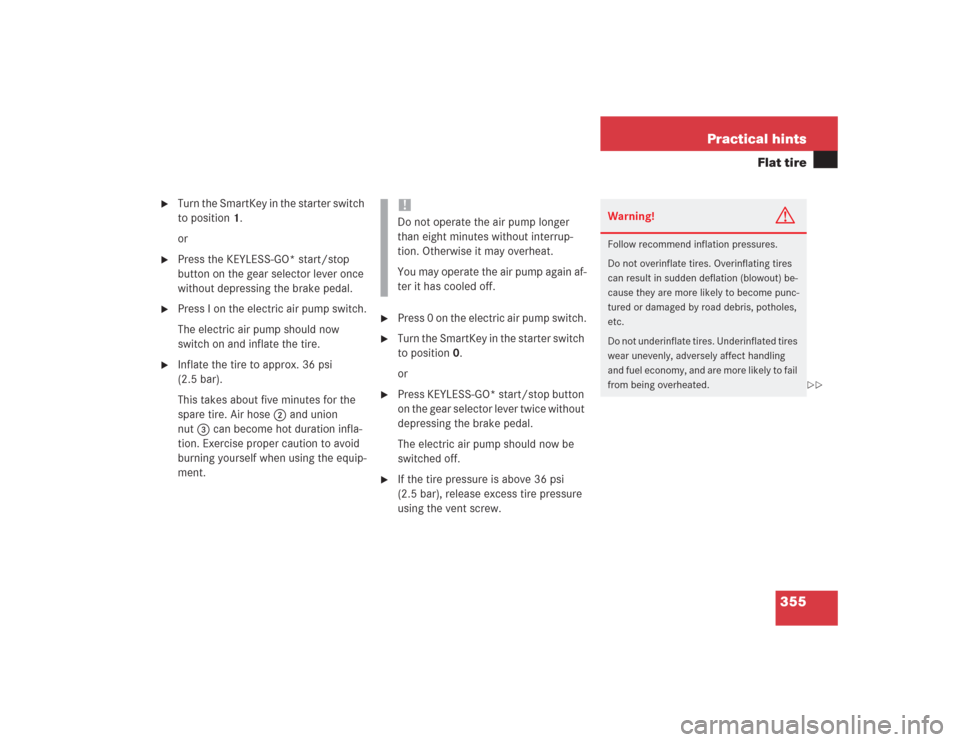
355 Practical hints
Flat tire
�
Turn the SmartKey in the starter switch
to position1.
or
�
Press the KEYLESS-GO* start/stop
button on the gear selector lever once
without depressing the brake pedal.
�
Press I on the electric air pump switch.
The electric air pump should now
switch on and inflate the tire.
�
Inflate the tire to approx. 36 psi
(2.5 bar).
This takes about five minutes for the
spare tire. Air hose 2 and union
nut3 can become hot duration infla-
tion. Exercise proper caution to avoid
burning yourself when using the equip-
ment.
�
Press 0 on the electric air pump switch.
�
Turn the SmartKey in the starter switch
to position0.
or
�
Press KEYLESS-GO* start/stop button
on the gear selector lever twice without
depressing the brake pedal.
The electric air pump should now be
switched off.
�
If the tire pressure is above 36 psi
(2.5 bar), release excess tire pressure
using the vent screw.!Do not operate the air pump longer
than eight minutes without interrup-
tion. Otherwise it may overheat.
You may operate the air pump again af-
ter it has cooled off.
Warning!
G
Follow recommend inflation pressures.
Do not overinflate tires. Overinflating tires
can result in sudden deflation (blowout) be-
cause they are more likely to become punc-
tured or damaged by road debris, potholes,
etc.
Do not underinflate tires. Underinflated tires
wear unevenly, adversely affect handling
and fuel economy, and are more likely to fail
from being overheated.
��
Page 357 of 434
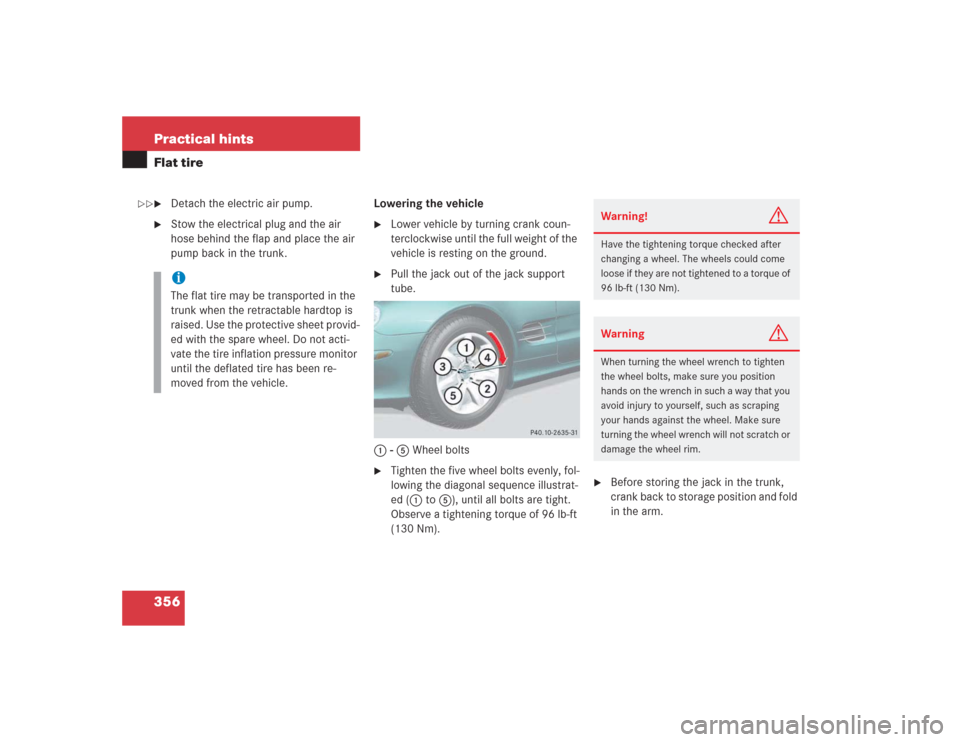
356 Practical hintsFlat tire�
Detach the electric air pump.
�
Stow the electrical plug and the air
hose behind the flap and place the air
pump back in the trunk.Lowering the vehicle
�
Lower vehicle by turning crank coun-
terclockwise until the full weight of the
vehicle is resting on the ground.
�
Pull the jack out of the jack support
tube.
1 - 5 Wheel bolts
�
Tighten the five wheel bolts evenly, fol-
lowing the diagonal sequence illustrat-
ed (1 to 5), until all bolts are tight.
Observe a tightening torque of 96 lb-ft
(130 Nm).
�
Before storing the jack in the trunk,
crank back to storage position and fold
in the arm.
iThe flat tire may be transported in the
trunk when the retractable hardtop is
raised. Use the protective sheet provid-
ed with the spare wheel. Do not acti-
vate the tire inflation pressure monitor
until the deflated tire has been re-
moved from the vehicle.
Warning!
G
Have the tightening torque checked after
changing a wheel. The wheels could come
loose if they are not tightened to a torque of
96 lb-ft (130 Nm).Warning
G
When turning the wheel wrench to tighten
the wheel bolts, make sure you position
hands on the wrench in such a way that you
avoid injury to yourself, such as scraping
your hands against the wheel. Make sure
turning the wheel wrench will not scratch or
damage the wheel rim.
��
Page 358 of 434
357 Practical hints
Flat tire
Replacing jack support tube cover�
Slide tongue of cover under the upper
edge of the tube opening.
�
Applying even pressure, press cover
until it snaps into place.
Be careful not to damage the locking
tabs or clamp the plastic retaining
strap.
Page 379 of 434
378 Technical dataRims and tires
�Rims and tiresOnly use tires and rims which have been
specifically developed for your vehicle and
tested and approved by Mercedes-Benz.
Other tires and rims can have detrimental
effects, such as�
Poor handling characteristics
�
Increased noise
�
Increased fuel consumption
!Moreover, tires and rims not approved
by Mercedes-Benz may, under load,
exhibit dimensional variations and dif-
ferent tire deformation characteristics
that could cause them to come into
contact with the vehicle body or axle
parts. This may result in damage to the
tires or the vehicle.
iFurther information on tires and rims is
available at any authorized
Mercedes-Benz Center. A tire inflation
pressure table is located on the fuel fill-
er flap of the vehicle. The tire pressure
should be checked regularly and
should only be adjusted on cold tires.
Follow tire manufacturer’s mainte-
nance recommendation included with
vehicle.
Page 396 of 434
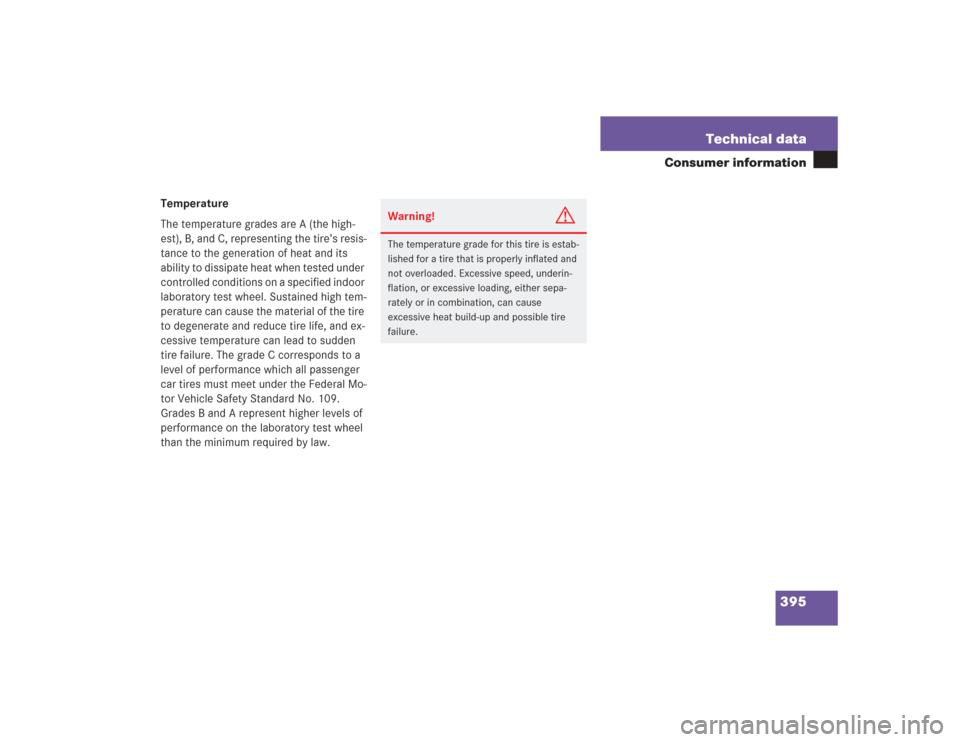
395 Technical data
Consumer information
Temperature
The temperature grades are A (the high-
est), B, and C, representing the tire’s resis-
tance to the generation of heat and its
ability to dissipate heat when tested under
controlled conditions on a specified indoor
laboratory test wheel. Sustained high tem-
perature can cause the material of the tire
to degenerate and reduce tire life, and ex-
cessive temperature can lead to sudden
tire failure. The grade C corresponds to a
level of performance which all passenger
car tires must meet under the Federal Mo-
tor Vehicle Safety Standard No. 109.
Grades B and A represent higher levels of
performance on the laboratory test wheel
than the minimum required by law.
Warning!
G
The temperature grade for this tire is estab-
lished for a tire that is properly inflated and
not overloaded. Excessive speed, underin-
flation, or excessive loading, either sepa-
rately or in combination, can cause
excessive heat build-up and possible tire
failure.
Page 399 of 434

398 Technical termsCAN system
(C
ontroller A
rea N
etwork)
Data bus network serving to control ve-
hicle functions such as door locking or
windshield wiping depending on vehi-
cle settings and/or ambient condi-
tions.
Cockpit
All instruments, switches, buttons and
indicator/warning lamps in the passen-
ger compartment needed for vehicle
operation and monitoring.
Collapsible tire
An especially compact spare tire that
must be inflated with a provided air
pump before using. It should only be
used to bring the vehicle to the nearest
service station.
COMAND
(Co
ckpit Man
agement and
D
ata System)
Information and operating center for
vehicle sound and communications
systems, including the radio, CD changer and navigation system, as well
as other optional equipment (e.g. tele-
phone).
Control system
The control system is used to call up
vehicle information and to change
component settings. Information and
messages appear in the multifunction
display. The driver uses the buttons on
the multifunction steering wheel to
navigate through the system and to ad-
just settings.
Cruise control
Driving convenience system for auto-
matically maintaining the vehicle speed
set by the driver.
Distronic*
A driving convenience cruise control
system which helps the driver maintain
a pre-selected speed:
�
If there is no vehicle directly ahead,
the system operates in the same
way as conventional cruise control.
�
If a slower moving vehicle is ahead,
Distronic* will reduce your vehicle
speed to the extent permitted by re-
duced throttle and up to 20% brak-
ing power to maintain the preset
minimum following distance.
DTR
(->Distr
onic*)
Engine number
The number set by the manufacturer
and placed on the cylinder block to
uniquely identify each engine pro-
duced.
ESP
(E
lectronic S
tability P
rogram)
Improves vehicle handling and direc-
tional stability.
ETD
(E
mergency Tensioning D
evice)
Device which deploys in certain frontal
and rear collisions exceeding the sys-
tem's threshold to tighten the seat
belts.
->SRS
Page 405 of 434
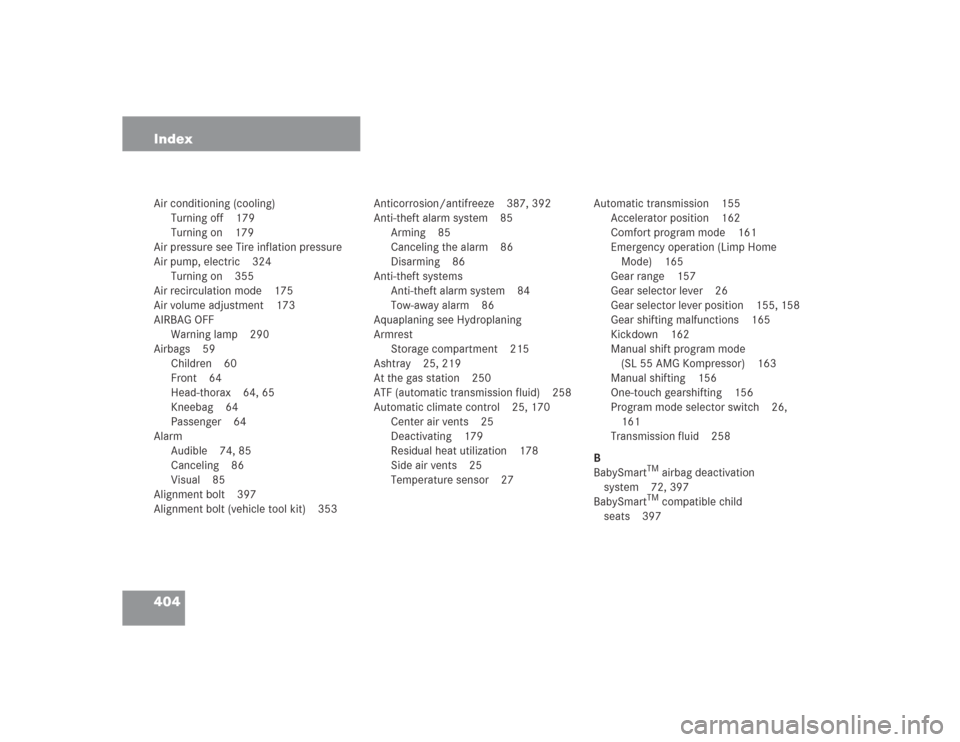
404 IndexAir conditioning (cooling)
Turning off 179
Turning on 179
Air pressure see Tire inflation pressure
Air pump, electric 324
Turning on 355
Air recirculation mode 175
Air volume adjustment 173
AIRBAG OFF
Warning lamp 290
Airbags 59
Children 60
Front 64
Head-thorax 64, 65
Kneebag 64
Passenger 64
Alarm
Audible 74, 85
Canceling 86
Visual 85
Alignment bolt 397
Alignment bolt (vehicle tool kit) 353Anticorrosion/antifreeze 387, 392
Anti-theft alarm system 85
Arming 85
Canceling the alarm 86
Disarming 86
Anti-theft systems
Anti-theft alarm system 84
Tow-away alarm 86
Aquaplaning see Hydroplaning
Armrest
Storage compartment 215
Ashtray 25, 219
At the gas station 250
ATF (automatic transmission fluid) 258
Automatic climate control 25, 170
Center air vents 25
Deactivating 179
Residual heat utilization 178
Side air vents 25
Temperature sensor 27Automatic transmission 155
Accelerator position 162
Comfort program mode 161
Emergency operation (Limp Home
Mode) 165
Gear range 157
Gear selector lever 26
Gear selector lever position 155, 158
Gear shifting malfunctions 165
Kickdown 162
Manual shift program mode
(SL 55 AMG Kompressor) 163
Manual shifting 156
One-touch gearshifting 156
Program mode selector switch 26,
161
Transmission fluid 258
B
BabySmart
TM airbag deactivation
system 72, 397
BabySmartTM compatible child
seats 397
Page 407 of 434
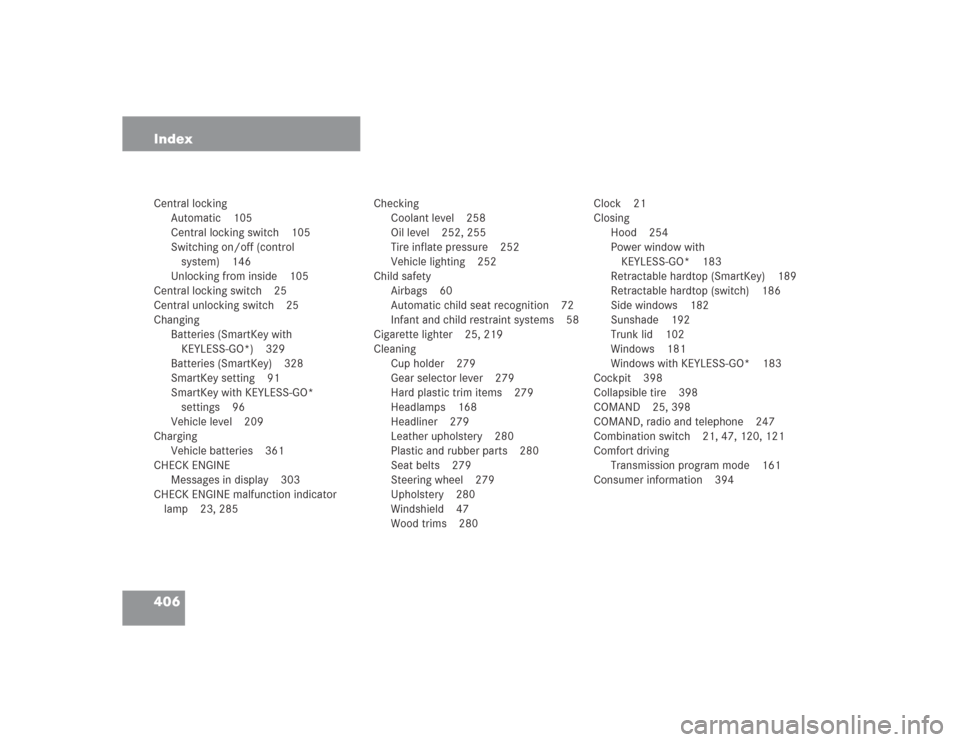
406 IndexCentral locking
Automatic 105
Central locking switch 105
Switching on/off (control
system) 146
Unlocking from inside 105
Central locking switch 25
Central unlocking switch 25
Changing
Batteries (SmartKey with
KEYLESS-GO*) 329
Batteries (SmartKey) 328
SmartKey setting 91
SmartKey with KEYLESS-GO*
settings 96
Vehicle level 209
Charging
Vehicle batteries 361
CHECK ENGINE
Messages in display 303
CHECK ENGINE malfunction indicator
lamp 23, 285Checking
Coolant level 258
Oil level 252, 255
Tire inflate pressure 252
Vehicle lighting 252
Child safety
Airbags 60
Automatic child seat recognition 72
Infant and child restraint systems 58
Cigarette lighter 25, 219
Cleaning
Cup holder 279
Gear selector lever 279
Hard plastic trim items 279
Headlamps 168
Headliner 279
Leather upholstery 280
Plastic and rubber parts 280
Seat belts 279
Steering wheel 279
Upholstery 280
Windshield 47
Wood trims 280Clock 21
Closing
Hood 254
Power window with
KEYLESS-GO* 183
Retractable hardtop (SmartKey) 189
Retractable hardtop (switch) 186
Side windows 182
Sunshade 192
Trunk lid 102
Windows 181
Windows with KEYLESS-GO* 183
Cockpit 398
Collapsible tire 398
COMAND 25, 398
COMAND, radio and telephone 247
Combination switch 21, 47, 120, 121
Comfort driving
Transmission program mode 161
Consumer information 394